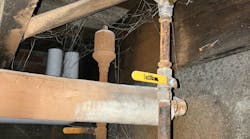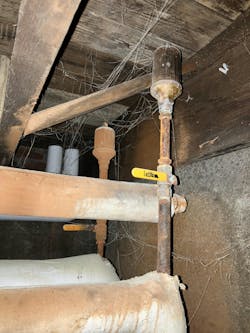Latest from Hydronics
Sponsored
Mis-Installed Boiler has This Writer Wearing His Walkin’ Shoes
The title, it just occurred to me, makes it sound like it may be my last column. The reference however, is to the Allman Brothers Band’s song, Dreams. Gregg Allman was writing some blues about getting out of bed, getting back in the rat race, and dreams he’ll never see. Kinda sounds like me daydreaming about retirement. I turn the clock to 68 this month, but no end date on my schedule, yet.
The service manager for a local heating contractor called recently to see if I could meet him at a steam job they were just starting to take care of. The building had recently been sold and the new owner was in the middle of renovations. From the brief description that the service manager gave me, I knew I would need my walkin’ shoes to evaluate the whole system.
When I got there, I noticed it was across the street from a hobby shop that I used to walk to when I was a kid. It was over two miles one way, just to buy a “Matchbox” toy truck with money given to me by my great uncles. I’m not sure today’s parent would allow that kind of walkabout.
Trouble at First Sight
We went down the stairs and took a turn into the boiler room. Right away I knew that we would be walkin’ around the whole basement to see what I could see else that was wrong. It was obvious from the near boiler piping that whoever installed this boiler wasn’t following the instructions supplied with this boiler or any other boiler.
The first rule of steam boiler near boiler piping is the installation of proper supply riser(s) that go to a header. The supply main(s) are then piped off the top of the header. The header is pitched towards one end to let the condensate drain back to the boiler through the equalizer pipe connecting the header to the Hartford Loop. This job didn’t have any of that normality.
There were two supply risers, one on each side. But instead of connecting to a header, they were piped directly to the original steam supply mains. One main distributed steam to one side of the building, while the other main went to the opposite side. Completely against all the rules laid down by the generations of steam men. And that was at first glance.
Return Side Problems
Once I digested that problem, I looked at the return side. Once again, there was something you don’t see every day. It was a condensate return unit, which isn’t that unusual for larger steam systems to return condensate from the far reaches of the building back to the boiler room. But at this smallish job, it was in the boiler room right next to the boiler.
A condensate return unit consists of a small tank, a pump and a float switch. The tank fills up with the condensate returning from the system. The float switch turns on the pump when the water level gets high enough and turns off the pump when the water level gets low enough. We don’t use them in the boiler room of a low pressure steam boiler to return the condensate directly to the boiler when it can be returned by gravity.
A boiler feed unit is used on larger jobs to help control the boiler waterline. It consists of a large tank, a pump, and a float valve. The pump is controlled from the waterline control, while the float valve occasionally adds water to the tank. Two different units to handle condensate for two different purposes.
Not only was the wrong unit installed, there was a steam trap on the inlet side of it. That is another red flag for me. The return pipe from the system at that point should only be carrying condensate and possibly air, but not steam. Sometimes it can be there on a one-pipe system, so it was time to start looking outside the boiler room. It didn’t take long to see the evidence of a two pipe system, the dry return.
Next stop was at an air handler with a steam coil in the duct work providing heat to a zone on the first floor. On the return side of the coil was a steam trap, which discharged into the wet return heading back to the boiler room and that trap in front of the condensate unit. An important rule of steam traps is that there can’t be two traps in series. It’s okay if they are in parallel, but you can’t install a trap after the first trap. Traps work on the principal of a differential pressure and the second trap messes around with that.
At the End of the Main
The picture shows what we found when we eventually got to the end of the supply main we were following. Now I see my fair share of cobwebs in my explorations, but I think it is the first time that I’ve seen ball valves before steam air vents. I’m a big fan of valves, but more on hot water systems than steam systems. What the hell, if you want to replace the main vent on a steam system, just turn the boiler off. There shouldn’t be any water where those vents are located.
But take a closer look at the vents. One is nice and clean, while the other is coated with rust. I’m speculating, but I guess the valves were installed to keep water from coming out. There is a float inside those vents to prevent that from happening, but obviously that wasn’t working. Instead of replacing a failed vent, someone installed a valve before the vent and closed it to keep the water from coming out.
However, that also keeps the air from releasing from the system to allow the steam to circulate and doesn’t address the real problem. Why is water trying to get out of the system at that point? Is the wet return clogged after all these years, or is it the “double trap” effect? The extra trap ahead of the condensate unit definitely should be removed and there’s probably crap in the wet return.
The walk around gave the service manager plenty to discuss with the building owner who may want to consider spending money to repair the heating system instead of spending money on renovating apartments.
Patrick Linhardt is a thirty-nine-year veteran of the wholesale side of the hydronic industry who has been designing and troubleshooting steam and hot water heating systems, pumps and controls on an almost daily basis. An educator and author, he is currently Hydronic Manager at the Corken Steel Products Co.
Patrick Linhardt
Patrick Linhardt is a forty-one-year veteran of the wholesale side of the hydronic industry who has been designing and troubleshooting steam and hot water heating systems, pumps and controls on an almost daily basis. An educator and author, he is currently Hydronic Manager at the Corken Steel Products Co.



